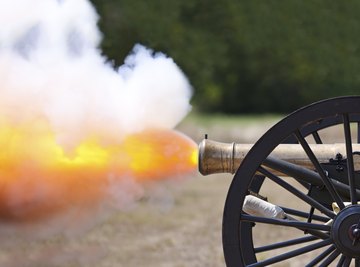
Solving for the flight time of a projectile is a problem often found in physics. You can use basic physics equations to determine the time any projectile, such as a baseball or rock, spends in the air. To solve for the flight time, you need to know the initial velocity, the angle of launch, and the height of launch relative to the landing elevation.
Determine the initial velocity and angle of launch. This information should be included in the problem.
Determine the initial vertical velocity by multiplying the sine of the angle of launch by the initial velocity. For example, if the initial velocity was 50 feet per second at an angle of 40 degrees, the initial vertical velocity would be about 32.14 feet per second.
Determine the time it takes for the projectile to reach its maximum height. Use the formula (0 - V) / -32.2 ft/s^2 = T where V is the initial vertical velocity found in step 2. In this formula, 0 represents the vertical velocity of the projectile at its peak and -32.2 ft/s^2 represents the acceleration due to gravity. For example, if your initial vertical velocity was 32.14 ft/s, it would take 0.998 seconds. The unit of ft/s^2 denotes feet per second squared.
Determine the height above or below the landing point that the projectile is launched from. For example, if the projectile is launched off a 40 foot high cliff, the height would be 40 feet.
Double the time if the height the projectile is launched from is equal to the level that it will land at. For example, if the projectile was launched and landed at the same height and it took one second to reach it's peak, the total time in flight would be two seconds. If the elevations are different, skip to step 6.
Determine how high the projectile traveled above its initial height by using the following formula where V is the initial vertical velocity and T is the time it takes to reach its peak: Height = V * T +1/2 * -32.2 ft/s^2 *T^2 For example, if you had an initial vertical velocity of 32.14 ft/s and a time of one second, the height would be 16.04 feet.
Determine the distance from the projectile's maximum height back to the ground by adding the height above the ground the projectile is launched from (use a negative number if the projectile is launched from below the level that it will land). For example, if the projectile was launched from 30 feet above where it landed and it went up 16.04 feet, the total height would be 46.04 feet.
Determine the time it takes to come down by dividing the distance by 16.1 ft/s^2 and then taking the square root of the result. For example, if the distance was 46.04 feet, the time would be about 1.69 seconds.
Add the time the projectile rises from step 3 to the time it falls from step 8 to determine the total flight time. For example, if it took 1 second to rise and 1.69 seconds to fall, the total time in flight would be 2.69 seconds.
References
About the Author
Mark Kennan is a writer based in the Kansas City area, specializing in personal finance and business topics. He has been writing since 2009 and has been published by "Quicken," "TurboTax," and "The Motley Fool."
